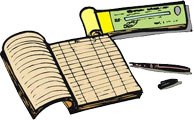How can Mrs. Garcia implement these activities?
Page 8: Prepare Materials
Before she trains her students to use PALS, Mrs. Garcia wants to make certain that all of her materials and resources are in place. She creates many of the materials herself and displays them so that her students can have immediate access to relevant information. Because there are a number of items to post, Mrs. Garcia groups them on three bulletin boards. Click the document links below to view a printable version of each.
 Procedures Procedures |
 Activities Activities |
 Recognition Recognition |
Note: Materials listed under “Recognition” will be discussed in more detail on Resource Page 11.
Mrs. Garcia also needs a stopwatch with which to monitor the length of the three activities and so that she’ll know when to tell her students to switch roles. A calculator will help her to tally the weekly point totals.
Preparing Student Materials
Next, Mrs. Garcia prepares the question and score cards that her students will keep in their PALS folders. Click on the samples below to view these materials in greater detail.
|
Note: The printable page includes two sets of cards.
|
Selecting Reading Materials
As she prepares materials for her students, Mrs. Garcia ponders the type of books she will choose for the pairs. She now knows that:

- Many types of reading material can be used (e.g., reading textbooks, library books, content-area books).
- Texts should reflect the ability level of the weaker reader (i.e., the lower-performing reader should be able to read the text with no more than 10 errors per 100 words).
- The reading material may be individualized. All pairs need not read from the same text.
- Once students have mastered the activities, they should, ideally, alternate between narrative and expository text.
- The text should be high-interest and age-appropriate.
- The expository text should relate to issues of some importance to high school students (e.g., employment, social relationships, health).


